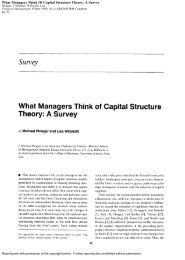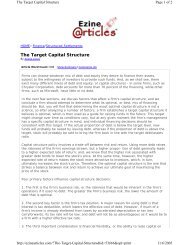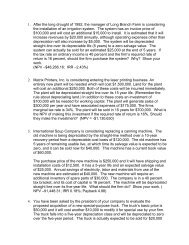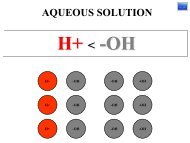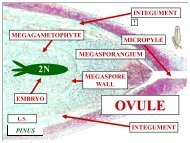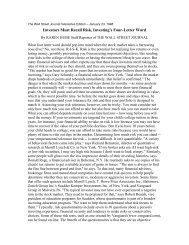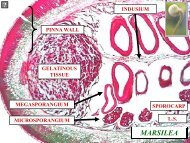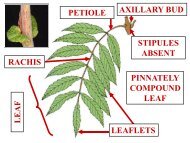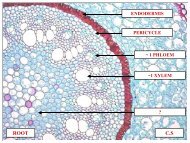Capital Budgeting Problem Set - Building The Pride
Capital Budgeting Problem Set - Building The Pride
Capital Budgeting Problem Set - Building The Pride
Create successful ePaper yourself
Turn your PDF publications into a flip-book with our unique Google optimized e-Paper software.
<strong>Capital</strong> <strong>Budgeting</strong> <strong>Problem</strong> <strong>Set</strong><br />
1. Your father-in-law offers you a chance to invest in a new business which he says will<br />
give you the following end-of-period cash flows:<br />
CF1 $5,000<br />
CF2 $7,000<br />
CF3 $8,000<br />
CF4 $10,000<br />
Your required rate of return is 13%. What is the most you can afford to pay for this<br />
investment assuming you believe the cash flow estimates are accurate? (PV<br />
$21,584.39)<br />
2. You have been offered the "privilege" of investing in a project that will return cash flows<br />
(starting at the end of year 3) of $1,000, $2,000, $3,000 and $2,000. If your required rate<br />
of return for this project is 12%, what is the PV of these cash flows? (PV $4,698.36)<br />
3. Why should changes in net working capital be included in the cash flow analysis of a<br />
project since any investments in working capital at the start-up of a project are assumed<br />
to be returned at the termination of the project?<br />
4. You’ve decided to build apartments on land you had been farming for years. Your spouse<br />
says that since you already own the land you should only count the cost of building the<br />
apartments as a relevant cost. What do you say?<br />
5. You are adding a machine in a corner of a building you already use for production and<br />
the firm’s accountant says you should add pro-rata share of the buildings heating bill as a<br />
relevant cost. How would you respond?<br />
6. Explain how to use replacement chain analysis. When would you need to use it and what<br />
are the advantages and disadvantages?<br />
7. Natural Fashions Inc. is looking at setting up a new manufacturing plant to produce<br />
apparel made from hemp. <strong>The</strong> company bought some land six years ago for $700,000 in<br />
anticipation of using it as a warehouse and distribution site, but the company decided not<br />
to build the warehouse at that time. This seemed the right decision at the time since they<br />
were sentenced to six years in prison for another type of “distribution” in which they<br />
were involved. <strong>The</strong> land was appraised last week for $750,000. <strong>The</strong> company wants to<br />
build its new manufacturing plant on this land; <strong>The</strong> plant will cost $8 million to build,<br />
and the site requires $250,000 worth of grading before it is suitable for construction.<br />
What is the proper cash flow amount to use as the initial investment in fixed assets when<br />
evaluating this project? Why? ($9,000,000)
8. Assuming a discount rate of 12% and the following after-tax cash flows:<br />
CF0 CF1 CF2 CF3 CF4 CF5 CF6<br />
- $10,000 6,000 3,000 3,000 -2,000 -1,000 5,000<br />
find the project’s:<br />
NPV ______________ (578.76)<br />
MIRR ______________ (12.89%)<br />
Payback ______________ (2.33 yr.)<br />
Profitability Index ______________ (1.0489)<br />
9. Consider the following cash flows:<br />
CFO CF1 CF2 CF3 CF4 CF5<br />
-$100,000 $34,000 $34,000 -$10,000 $40,000 $50,000<br />
Assuming k=11 percent, calculate the following numbers. If any numbers might be<br />
questionable the find another way to verify the number. Show all your work.<br />
NPV ___________________ ($6,935.68)<br />
IRR ___________________ (13.56%)<br />
Payback ___________________ (4.04)<br />
MIRR ___________________ (12.4%)<br />
PI ___________________ (1.065)<br />
10. You are evaluating a project with the following cash flows:<br />
CFO CF1 CF2 CF3 CF4 CF5<br />
-25,000 6,000 7,000 -4,000 15,000 10,000<br />
Assume a required rate of return of 10%.<br />
Find the NPV? (-311.17)<br />
Find the Payback ? (4.1 yr.)<br />
Should you calculate the project’s IRR? Why or why not?<br />
Find the MIRR? (9.75%)
11. A project has the following cash flows: (assume a required rate of return of 10%)<br />
CF0 CF1 CF2 CF3 CF4 CF5<br />
-$100,000 $40,000 $40,000 $60,000 -$20,000 $10,000<br />
Can you use IRR to determine if this is an attractive project? Why or why not?<br />
Calculate the MIRR for this project.<br />
12. What are the problems associated with exclusively using IRR to choose investment<br />
projects?<br />
13. Why can’t you use IRR to choose between mutually exclusive projects?<br />
14. Explain the advantages that MIRR has over IRR<br />
15. What are the disadvantages of using regular payback?<br />
16. What is the one advantage that IRR has over NPV?<br />
17. In outline form, explain the problems associated with using IRR both with independent<br />
and mutually exclusive projects. Make sure you identify the source of the problems if<br />
relevant.<br />
Even after you share the above information with your boss why might she still want you<br />
to use IRR in all your presentations to the Board of Directors?<br />
18. <strong>The</strong> Malone Truck Company is considering opening a new loading dock at a cost of<br />
$280,000 for new equipment and will require an investment of $20,000 in accounts<br />
receivable. <strong>The</strong> life of the new equipment is seven years. <strong>The</strong> equipment will be<br />
depreciated straight-line over its seven-year life to a salvage value of zero, even though it<br />
is expected that the equipment to have revenues of $250,000 per year over the next seven<br />
years, but revenues from the firm’s other loading docks is expected to decrease by a total<br />
of $25,000 per year because some of their business will move to the new loading dock.<br />
Fixed costs for the new dock are estimated to be $26,000 per year and variable costs are<br />
expected to be $155,000 per year. <strong>The</strong> firms tax rate is 34% and the required rate of<br />
return is 15%. What should the firm do? (NPV -112,599.78; IRR 1.93%)<br />
19. Dagny Corporation is evaluating whether to replace a printing press with a newer model,<br />
which, owing to more efficient operation, will reduce operating costs from $40,000 to<br />
$32,000 per year. Sales are not expected to change. <strong>The</strong> old press cost $60,000 when<br />
purchased five years ago, had an estimated useful life of 15 years, zero salvage value at<br />
the end of its useful life and is being depreciated straight-line. At present, its market<br />
value is estimated to be $40,000, if sold outright. <strong>The</strong> new press costs $80,000 and would<br />
be depreciated straight-line to a zero salvage over a ten-year life. However, management<br />
expects to be able to sell the new press for $15,000 at the end of ten years. <strong>The</strong>
corporation has a 40% marginal tax rate and a cost of capital of 15%. What should<br />
management do? (NPV –5,655.22; IRR 11.47%)<br />
20. John Burke, Inc. is considering leasing a machine for eight years at an annual rental of<br />
$34,000, which includes all maintenance. <strong>The</strong> alternative is to purchase the machine for<br />
$190,000 and have maintenance expenses of $15,000 per year. However, if you purchase<br />
the machine you get to depreciate it straight-line over the eight year period. Assume a<br />
zero salvage value at the end of eight years and a 40% tax rate. <strong>The</strong> firm’s required rate<br />
of return is 12%. Should the firm buy or lease? You will have to use your cash flow sheet<br />
in order to determine the annual cost of purchasing the machine. (NPV –187,516.18;<br />
EAC $37,747.54)<br />
21. You are evaluating two different sound mixers. <strong>The</strong> JazzMaster costs $45,000 and has a<br />
three-year life, and costs $5,000 per year to operate. <strong>The</strong> DiscoMaster costs $65,000, has<br />
a five-year life and costs $4,000 per year to operate. <strong>The</strong> relevant discount rate is 12%.<br />
Ignoring depreciation and taxes, compute the equivalent annual cost for both. Which do<br />
you prefer? (EAC of JazzMaster 23,735.71; EAC of DiscoMaster 22,031.63)<br />
22. What error(s) might be introduced by using nominal cash flows and discount rates to<br />
calculate equivalent annual costs?<br />
23. After the long drought of 1992, the manager of Long Branch Farm is considering the<br />
installation of an irrigation system. <strong>The</strong> system has an invoice price of $100,000 and will<br />
cost an additional $15,000 to install. It is estimated that it will increase revenues by<br />
$20,000 annually, although operating expenses other than depreciation will also increase<br />
by $5,000. <strong>The</strong> system will be depreciated straight-line over its depreciable life (5 years)<br />
to a zero salvage value. <strong>The</strong> system can actually be sold for an estimated $25,000 at the<br />
end of 5 years. If the tax rate on ordinary income is 40 percent and the firm’s required<br />
rate of return is 16 percent, should the firm purchase the system? Why? Show your<br />
work. (NPV –48,266.16; IRR –2.43%)<br />
24. If Long Branch farms had spent $5,000 over the previous year doing studies of longrange<br />
weather patterns in order to determine if they could use an irrigation system<br />
effectively, how should that cost be taken into account in today’s analysis of this<br />
particular irrigation system?<br />
25. Top-Sider is considering the purchase of a new leather-cutting machine to replace an<br />
existing machine that has a book value of $3,000 and can be sold today for $1,500. <strong>The</strong><br />
old machine is being depreciated on a straight-line basis and its estimated salvage value<br />
in 3 years is zero. <strong>The</strong> new machine will reduce costs (before taxes) by $7,000 per year.<br />
<strong>The</strong> new machine has a 3-year life, it costs $14,000, and it can be sold for an expected<br />
$2,000 at the end of the third year. If the new machine is purchased it will require the<br />
firm to maintain an additional $500 in spare parts inventory. <strong>The</strong> new machine would be<br />
depreciated straight-line over its 3-year life. Assuming a 40 percent tax rate and a<br />
required rate of return of 13 percent, what should the firm do? Show your work.
(NPV $2,158.84; IRR 22.55%; MIRR 19.21% CF 0 = -12,400 CF 1-3 = 5667 CF T =<br />
1700)<br />
26. What is the difference between IRR and MIRR? Is MIRR an improvement over IRR? If<br />
so, why? Calculate the MIRR of at least one of the projects on this exam and show your<br />
work here.<br />
27. You are considering two different vacuums to use in your new hotel. <strong>The</strong> Hoover Pro-5<br />
would cost $675 each and would have maintenance and supply costs of $125 per year<br />
over its 4-year life. <strong>The</strong> new Porsche Turbo-Magnum model would cost $900 and would<br />
not require bags since it uses a new bag-less dirt chamber. It would have maintenance<br />
expense of $90 per year over its 6-year life. Your required rate of return would be 9%<br />
and you are in a 40% tax rate. Either vacuum would be depreciated straight-line over its<br />
useful life. Which should you choose? Show your work. (Hoover NPV –699.30 and<br />
EAA -215.85; Porsche NPV -873.08, EAA -194.63)<br />
28. Two projects have the following cash flows:<br />
Project A: -10,000 4,000 3,000 6,000<br />
Project B -8,000 3,200 2,800 4,500<br />
Find the IRR and NPV of both projects. Assume a 10% required rate of return. Is there a<br />
conflict? Which project should you choose?<br />
29. IBC Industries recently purchased three new injection molding machines and spent<br />
$100,000 having their entire work force trained to use the new machines. <strong>The</strong> machines<br />
have worked very well and cut defects by 30%, so IBC is running CF figures in order to<br />
determine if they should replace three more of the old style machines with the new<br />
machines. Is the $10,000 training cost spent when the first machines were bought a<br />
relevant CF for the purchase of the second group of machines? Why or why not?<br />
30. A Brazilian bank needs to purchase a new computer system for its New York office. <strong>The</strong><br />
bank can either lease a new system for five years for $100,000 per year or they can<br />
purchase their own system which will cost $450,000 and have operating costs of $20,000<br />
per year. <strong>The</strong> required rate of return for the bank is 10%. Find the EAC of purchasing the<br />
new computer system in order to determine if the bank should lease or buy the system.<br />
Assume that either system would be essentially worthless at the end of the five year<br />
period. (138,708.87 Ignore D+T)<br />
31. Matrix Printers, Inc. is considering entering the laser printing business. An entirely new<br />
plant will be needed which will cost $1,500,000. Land for the plant will cost an<br />
additional $250,000. Both of these costs will be incurred immediately. <strong>The</strong> plant will be<br />
depreciated straight line over its 15 year life. (Remember the rule about depreciating<br />
land.) In addition to these costs an investment of $100,000 will be needed for working<br />
capital. <strong>The</strong> plant will generate sales of $300,000 per year and have associated expenses<br />
of $175,000. <strong>The</strong> firms marginal tax rate is 34%. <strong>The</strong> plant will be sold in 15 years for
$700,000 ($200,000 for the land and $500,000 for the plant). What is the NPV of making<br />
this investment if the required rate of return is 16%. Should they make the investment?<br />
(NPV = -$1,130,630)<br />
32. Matrix Printers, Inc. discovered a totally new method of laser printing and insiders have<br />
stated that this the most revolutionary breakthrough ever made by the firm. Matrix<br />
estimates that to put the new printers into the production the firm will have to invest<br />
$1,000,000 and that the firm will be able to have positive cash flows of $500,000 per year<br />
for the next four years until the competition catches up. Matrix required rate of return is<br />
12%. What is the IRR on this new project? Is this a realistic estimate of Matrix actual<br />
earnings over the four year period? Can you help them make a better estimate of the<br />
firm's actual IRR over the period? What is that more realistic rate and why is it better?<br />
(IRR 34.90%; MIRR 24.33%)<br />
33. What is it that makes MIRR superior to IRR? Be precise and thorough.<br />
34. List three potential problems with using IRR in making capital budgeting decisions.<br />
35. Given the advantages of NPV over all other capital budgeting tools why would you ever<br />
want to compute payback, IRR, MIRR or PI?<br />
36. Would there ever be situations where a firm would knowingly accept projects with a<br />
negative NPV? If so, what might these be?<br />
37. Describe how an investment opportunity schedule and an MCC schedule can be used<br />
together to determine the optimal capital budget. What would you do if a break point in<br />
the MCC schedule came in the middle of one of the projects on the investment<br />
opportunity schedule. you may use a simple example to illustrate , if you like.<br />
38. Capitol City transfer Company is considering building a new terminal in Salt Lake City.<br />
If the company goes ahead with the project, it will spend $1 million immediately and<br />
another $1 million at the end of year 1. It will then receive net cash flows of $500,000 at<br />
the end of years 2-5, and it expects to sell the property for $1 million at the end of year 6.<br />
<strong>The</strong> company's cost of capital is 12 percent, and it used the MIRR criterion for capital<br />
budgeting decisions. What is the project's MIRR? (MIRR 11.7%)<br />
39. Mary was thinking about buying some little lambs and raising the to sell. the lambs cost<br />
$5,000 (lamb prices are now abnormally low and may never be this low again) and Mary<br />
thought hat she could sell several lambs each year and thus receive $3,500 per year for<br />
the next three years. Mary, being the sophisticated investor that she was, calculated the<br />
IRR on this investment and found it to be almost 49%. Mary thought that this seemed<br />
very high, given that she normally earned about 15% on lamb investments. If Mary’s<br />
returns are usually in the 15% range and will probably be about that in the further, can<br />
you help Mary to make a more realistic estimate of the actual rate of return that she can<br />
earn on her lamb investment over the next three years? Show and explain all of your<br />
work. (MIRR 34.46%)
40. What is the NPV of the following set of cash flows if the required rate of return is 18%?<br />
Year Cash Flow<br />
0 -$50,000<br />
1 – 5,000<br />
2 50,000<br />
3 50,000<br />
4 –5,000<br />
Would you want to calculate IRR on this investment? Why or why not?<br />
41. Ball Corporation is currently evaluating two mutually exclusive projects which have the<br />
following net cash flows:<br />
A<br />
B<br />
0 -$5,000 -$10,000<br />
1 3,000 3,500<br />
2 3,000 3,500<br />
3 3,000 3,500<br />
4 3,500<br />
5 3,500<br />
6 3,500<br />
Both projects have a cost of capital of 10 percent. Totally new equipment must be<br />
procured in 6 years, but Project A would be replicated if it were chosen. Which project<br />
should Ball select, and why?<br />
42. <strong>The</strong> Harris Company has a choice between two mutually exclusive projects, S, which has<br />
a cost of $200,000 and will provide cash flows of $100,000 per year at the end of each of<br />
the next three years, or L, which costs $425,000 and will provide cash flows of $200,000<br />
per year for three years. Harris’s cost of capital is 10 percent.<br />
Find the NPV and IRR of each project<br />
What factors could possibly be causing the conflict between NPV and IRR?<br />
Which one should be chosen?<br />
43. Obviously, if a project has a positive NPV it will have a PI greater than 1.0. Should you<br />
automatically choose projects with the highest PI if you are choosing between mutually<br />
exclusive projects?<br />
44. What problems would it cause if a corporation used the same required rate of return for<br />
each project it considered in every division? How do corporations handle this problem in<br />
practice?
45. Although NPV and IRR give the same accept/reject decision they can often conflict when<br />
choosing between mutually exclusive projects. Why?<br />
46. International Soup Company is considering replacing a canning machine. <strong>The</strong> old<br />
machine is being depreciated by the straight-line method over a 10-year recovery period<br />
from a depreciable cost basis of $120,000. <strong>The</strong> old machine has 5 years of remaining<br />
usable live, at which time its salvage value is expected to be zero, and it can be sold now<br />
for $40,000. This machine has a current book value of $60,000.<br />
<strong>The</strong> purchase price of the new machine is $250,000 and it will have shipping and<br />
installation costs of $12,500. It has a 5-year life and an expected salvage value of<br />
$25,000. Annual savings of electricity, labor and materials from use of the new machine<br />
are estimated at $40,000. <strong>The</strong> new machine will require an additional inventory of spare<br />
parts of $30,000. <strong>The</strong> company is in a 40 percent tax bracket, and its cost of capital is 16<br />
percent. <strong>The</strong> machine will be depreciated straight line over its five-year life. What<br />
should the firm do? Show your work. ( NPV –91,448.31; IRR 0.18%; Payback 4.98)<br />
47. You have become very successful and are considering the purchase of a plane for your<br />
firm. <strong>The</strong> Piper model has an initial cost of $375,000, annual operating costs of $24,000<br />
and a salvage value of $150,000. Its estimated holding period is 7 years. <strong>The</strong> Cessna<br />
model has an initial cost of $325,000, but annual operating costs of $29,500 and an<br />
estimated salvage value of $100,000. Its estimated holding period is 8 years. Your cost<br />
of capital is fifteen percent. Ignoring depreciation and taxes, which model would be the<br />
best choice assuming they both would perform the required tasks?<br />
48. We project unit sales for a new household-use laser-guided cockroach search and destroy<br />
system (a joint venture of Lockheed and Aerojet) as follows:<br />
Year 1 53,000 units<br />
Year 2 65,000 units<br />
Year 3 76,000 units<br />
Year 4 86,000 units<br />
Year 5 86,000 units<br />
<strong>The</strong> new system will be priced to sell at $95 each. <strong>The</strong> cockroach eradicator project will<br />
require $585,000 in new working capital. <strong>The</strong> variable cost per unit is $60, and total fixed<br />
costs are $25,000 per year. <strong>The</strong> equipment necessary to begin production will cost a total<br />
of $6,500,000. This equipment can be depreciated straight-line over its useful life of five<br />
years. In five years it will actually be worth about 30 percent of its cost. <strong>The</strong> relevant tax<br />
rate is 34%, and required return is 20%. Based on these preliminary estimates, what is the<br />
NPV of the project? (NPV -$224,835.20)<br />
49. <strong>The</strong> Shadrach Corporation is thinking about replacing one of its large furnaces with a<br />
newer, more efficient model. <strong>The</strong> new model would cost $150,000, but would save<br />
$35,000 per year in fuel costs. <strong>The</strong> new model could be depreciated straight-line over its<br />
five year life to a salvage value of zero. <strong>The</strong> furnace could actually be sold for $45,000 at
that time. <strong>The</strong> old furnace cost $100,000 two years ago, could currently be sold for<br />
$60,000, and was being depreciated straight-line over its 7 year life. <strong>The</strong> old furnace was<br />
not expected to have any value at the end of its useful life in 5 years. Assuming a tax rate<br />
of 34% and a 12% required rate of return, should you replace the old furnace? (NPV<br />
33,268.43)<br />
50. Rick Bardles and Ed James are considering building a new bottling plant to meet<br />
expected future demand for their new line of tropical coolers. <strong>The</strong>y are considering<br />
putting it on a plot of land they have owned for three years. <strong>The</strong>y are in the process of<br />
analyzing the idea and comparing it to some others. Bardles says, “Ed, when we do this<br />
analysis, we should put in an amount for the cost of the land equal to what we paid for it.<br />
After all it did cost us a pretty penny.” James retorts, “No, I don’t care how much it costwe<br />
have already paid for it. It is what they call a sunk cost. <strong>The</strong> cost of the land shouldn’t<br />
be considered.” What would you say to Bardles and James?<br />
51. Meals on Wings, Inc. supplies prepared meals for corporate aircraft (a opposed to<br />
airlines) and it needs to purchase new broilers. If the broilers are purchased, they will<br />
replace old broilers purchased 10 years ago for $105,000 and which are being depreciated<br />
on a straight-line basis to a zero salvage value (15-yeardepreciable life). <strong>The</strong> old broilers<br />
can be sold for $60,000 the new broilers will cost $200,000 installed and will be<br />
depreciated straight -line over their 5-year class life to a salvage value of zero, although<br />
they are expected to have a salvage value of $12,000 in five years. <strong>The</strong> firm expects to<br />
increase its revenues by $18,000 per year if the new broilers are purchased, but cash<br />
expenses will also increases by $2,500 per year. If the firm's cost of capital is 10 percent<br />
and its tax rate is 34 percent, what is the NPV of the broilers? (NPV -62,269.93)<br />
52. You have been asked by the president of your company to evaluate the proposed<br />
acquisition of a new special-purpose truck. <strong>The</strong> truck’s basic price is $50,000 and it will<br />
cost another $10,000 to modify it for special use by your firm. <strong>The</strong> truck falls into a fiveyear<br />
depreciation class and will be depreciated to zero over the five-year period. <strong>The</strong><br />
truck is actually expected to be sold for $20,000 after three years when the project is<br />
ended. Use of the truck will require an increase in net working capital of $2,000 (spare<br />
parts). <strong>The</strong> truck will have no effect on revenue, but it is expected to save the firm<br />
$22,000 per year in before-tax operating costs, mainly labor. <strong>The</strong> firms marginal tax rate<br />
is 40 percent and the required rate of return on the project is 13 percent. What should you<br />
do?(NPV -$3143.27; IRR 10.39%)<br />
53. You have been asked by the president of your firm to evaluate the proposed acquisition<br />
of spectrometer for the firm’s R&D department. <strong>The</strong> equipment’s base price is $140,000<br />
and it would cost another $30,000 to modify it for special use by your firm. <strong>The</strong><br />
spectrometer (plus the modification) would be depreciated straight-line over its five-year<br />
life to a salvage value of zero, but it is expected that the instrument would be sold after 3<br />
years for $60,000. Use of the equipment would require an increase in net working capital<br />
(spare parts inventory) of $8,000. <strong>The</strong> spectrometer would have no effect on revenues,<br />
but it is expected to save the firm $50,000 per year in before-tax operating costs, mainly
labor. <strong>The</strong> firm’s marginal tax rate is 34%. If the firm’s cost of capital is 12%, should the<br />
equipment be purchased?(NPV= -20,637.30 IRR= 6.13%)<br />
54. <strong>The</strong> Erley Equipment Company purchased a machine 5 years ago at a cost of $100,000.<br />
the machine had an expected life of 10 years at the time of purchase, and an expected<br />
salvage value of zero at the end of 10 years. It is being depreciated by the straight-line<br />
method over its 10-year life.<br />
A new machine can be purchased for $150,000, including installation costs. During its 5-<br />
year life, it will reduce cash operating expenses by $50,000 per year. Sales are not<br />
expected to change. At the end of its useful life, the machine is estimated to be worthless.<br />
<strong>The</strong> machine would be depreciated straight-line over 5 years.<br />
<strong>The</strong> old machine can be sold for $65,000. <strong>The</strong> firm’s tax rate is 34%. the appropriate<br />
discount rate is 16%. Should the replacement machine be purchased? Show your work.<br />
(NPV at 16% 40,216.89; IRR 33.92%)<br />
55. <strong>The</strong> president of Real Time Inc. has asked you to evaluate the proposed acquisition of a<br />
new computer. <strong>The</strong> computer’s price is $40,000 and it would cost $5,000 to install the<br />
system. <strong>The</strong> system falls into the 3-year depreciation class (straight-line to zero book<br />
value). Purchase of the computer would require an increase in net working capital of<br />
$2000. <strong>The</strong> computer would increase the firm’s revenues by $20,000 per year, but would<br />
also increase the firm’s operating costs by $5,000 per year. <strong>The</strong> computer is expected to<br />
be used for 3 years and then be sold for $25,000. <strong>The</strong> firm’s marginal tax rate is 40<br />
percent, and the project’s cost of capital is 14 percent. What should the firm do? Show<br />
your work. (NPV –701.00)<br />
56. Blue Note Jazz Productions has decided to cash in on the country craze by starting a<br />
subsidiary that will promote concerts by "Country Jazz" artists for the next three years.<br />
<strong>The</strong> country music boom is expected to subside by this time and the subsidiary will be<br />
folded. Blue Note expects that average ticket prices will be $35 and that ticket sales for<br />
the three years will be 300,000 per year. Fixed cost each year are expected to be<br />
$3,000,000 and variable costs are expected to be 25% of sales. <strong>The</strong> subsidiary will need<br />
$4,000,000 in new equipment to start up and requires a $300,000 investment in working<br />
capital. <strong>The</strong> $4,000,000 in equipment will be depreciated straight-line over five years to a<br />
zero salvage value, but will be sold at the end of three years for an estimated $1,500,000.<br />
What is the NPV of this new investment if the firm's required rate of return is 12%? <strong>The</strong><br />
firm's marginal tax rate is 40%. What is the IRR? Should the project be accepted? (IRR<br />
37.20%; NPV $2,276,314.23; MIRR 29.04%)<br />
57. Mom’s Cookies, Inc. is considering the purchase of a new cookie oven. <strong>The</strong> original cost<br />
of the old oven was $30,000; it is now 5 years old, and it has a current market value of<br />
$5,000. <strong>The</strong> old oven is being depreciated over a 10-year life towards a zero estimated<br />
salvage value on a straight line basis, resulting in a current book value of $15,000 and an<br />
annual depreciation expense of $3,000. Management is contemplating the purchase of a<br />
new oven whose cost is $25,000 and whose estimated salvage value is zero. Expected
cash savings from the new oven are $20,000 a year (before tax). Depreciation is<br />
computed using 5-year straight-line depreciation and the cost of capital is 10 percent.<br />
Assume a 40 percent tax rate. What is the NPV of the new oven? (NPV $32,522.07;<br />
IRR 75.15%)<br />
58. Mc Laughlin Mills is evaluating the proposed acquisition of a new milling machine. <strong>The</strong><br />
machine’s base price is $180,000 and it would cost another $25,000 to modify it for<br />
special use by your firm. <strong>The</strong> machine would be depreciated straight-line over 5 years<br />
and it would be sold after three years for $80,000. <strong>The</strong> machine would require an increase<br />
in net working capital (inventory) of $7,500. <strong>The</strong> machine would have no effect on<br />
revenues, but it is expected to save the firm $75,000 per year in before-tax operating<br />
costs, mainly labor. McLaughlin’s marginal tax rate is 34% and the appropriate discount<br />
rate is 10%. What should they do? (NPV 11,516.83)<br />
59. <strong>The</strong> Wingler Equipment Company purchased a machine 5 years ago at a cost of<br />
$100,000. It had an expected life of 10 years at the time of purchase and an expected<br />
salvage value of zero at the end of the 10 years. It is being depreciated by the straight line<br />
method toward a salvage value of zero.<br />
A new machine can be purchased for $150,000, including installation costs. Over its 5-<br />
year life, it will reduce cash operating expenses by $50,000 per year. Sales are not<br />
expected to change. At the end of its useful life, the machine is expected to be sold for<br />
$40,000. <strong>The</strong> machine would be fully depreciated straight-line over 5 years (30,000 per<br />
year).<br />
<strong>The</strong> old machine can be sold today for $65,000. <strong>The</strong> firm’s tax rate is 34%. <strong>The</strong><br />
appropriate discount rate is 15%. What should they do? (NPV 56,441.24)<br />
60. <strong>The</strong> Wingler Equipment company purchased a machine two years ago at a cost of<br />
$77,000. It had an expected life of seven years at the time of purchase and was being<br />
depreciated straight-line over its expected life to a salvage value of zero. This machine<br />
could be sold today for $45,000<br />
A new machine with breakthrough technology can be purchased for $140,000 and it<br />
would cost $10,000 to install. Over its five-year expected life it will reduce cash<br />
operating expenses by $50,000 per year. Sales are not expected to change. At the end of<br />
its useful life the machine is estimated to be worth $20,000. <strong>The</strong> machine, if purchased,<br />
will be depreciated straight line over its expected life down to a salvage value to zero.<br />
What should you do if your required rate of return is sixteen percent? (NPV $32,878.07;<br />
IRR 28.68%)<br />
61. Southwest Airlines is considering the purchase of a new baggage-handling machine that<br />
moves bags quicker and with less damage. <strong>The</strong> cost is $160,000. <strong>The</strong> machine will be<br />
depreciated using the straight line method over its seven year life. If the machine is<br />
purchased, SWA will save $31,000 per year in damaged bags costs during the first five<br />
years. Because of higher maintenance costs during the last two years the savings will
only be $28,000. the firm is in a34% tax bracket. Given that the firm’s required rate of<br />
return is 13%, compute the NPV and IRR of the investment. Should they make the<br />
investment? (NPV –36,936.03; IRR 5.08%)<br />
62. Mills Corp. is considering adopting one of two machines. Machine A requires an up-front<br />
expenditure of $450,000, has an expected life of two years, and will generate positive<br />
AFTER-TAX cash flows of $350,000 per year. Machine B requires an expenditure of<br />
$1,000,000 and has an expected life of three years and will generate AFTER-TAX cash<br />
flows of $450,000 per year. <strong>The</strong> cost of capital is 10%. What is the EAA of the better<br />
machine? (EAA of A 90,714.29; EAA of B 47,885.20)<br />
63. Filkins Fabric Company is considering the replacement of its old, fully depreciated<br />
knitting machine. Two new models are available: Machine 190-3 which has a cost of<br />
$190,000, a three-year expected life, and after-tax cash flows (labor savings and<br />
depreciation) of $87,000 per year; and Machine 360-6 which has a cost of $360,000, a<br />
six-year life, and after-tax cash flows of $98,300 per year. Assume that Filkins’ cost of<br />
capital is 14%. Which machine should they buy assuming they expect to be in business at<br />
least 6 years.<br />
(NPV of M3 $11,981.99, EAA 5,161.06; NPV of M6 $22,256.02, EAA 5,723.30)<br />
What implicit assumption is built into this analysis?<br />
64. Sony Corporation is considering the purchase of a new phone system for a sales office in<br />
Boise, Idaho. <strong>The</strong> Lucent Technologies system costs $54,000, has annual operating<br />
expenses of $4,000 and an expected life of 9 years. <strong>The</strong> Toshiba system has a cost of<br />
$48,000, annual operating expenses of $4,000 and an expected life of 7 years. Ignoring<br />
depreciation and taxes and assuming a cost of capital of 9 percent for such an investment,<br />
which system should Sony purchase? You are free to use either replacement chain or<br />
EAA/EAC analysis.<br />
( Lucent EAA -13,007.14, NPV-77,980.99; Toshiba EAA -13,537.14, NPV -68,131.81)<br />
65. You are evaluating two different silicon wafer milling machines. the Techron I cost<br />
$150,000, has three-year life, and has pre-tax operating cost of $30,000 per year. the<br />
Techron II costs $250,000, has a five-year life, and has pre-tax operating costs of $17,000<br />
per year. For both milling machines, use straight-line depreciation to zero over the<br />
project’s life and assume a salvage value of $20,000. If your tax rate is 35 percent and<br />
your discount rate is 18 percent, compute the EAC for both machines. Which do you<br />
prefer? Why? (NPV of I is –146,436.34 ad EAC –67,349.57; NPV of II-224,147.33 and<br />
EAC 71,677.35)<br />
66. A small real estate office needs a new copier. <strong>The</strong>y have their choice between<br />
leasing a new copier for $2,000 per year with all maintenance included or they can<br />
purchase their own copier for $4,200 and would incur $1,200 per year in operating costs.<br />
Paper and cartridge costs for the copier would be identical in either case. <strong>The</strong> lease would<br />
be for a total of 6 years and the copier, if bought, would have a useful life of 6 years and<br />
no expected salvage value at the end of that time. Determine if owning the machine
would be cheaper on a per-year basis than leasing the machine. <strong>The</strong>n firm’s tax rate is<br />
34% and the proper required rate of return for the project would be 7%. (Annual after-tax<br />
cost of lease is $1,320 per year. NPV for purchase of copier is -$6840.66 giving an EAC<br />
of $1,435.14 per year. Take the one with the lowest annual cost – the lease.)



